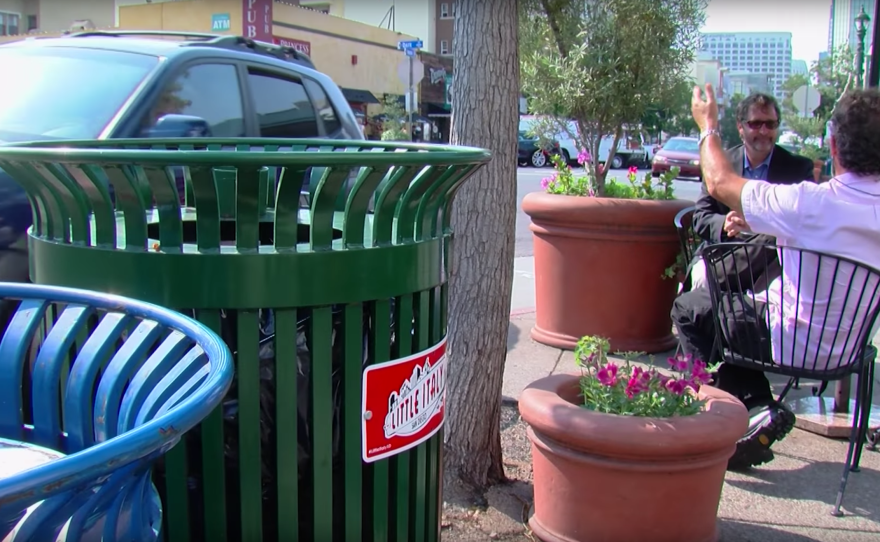Marco Li Mandri approaches a card table on the sidewalk of India Street in Little Italy where men interrupt their game to greet him with smiles and kisses on the cheek. He introduces me to “the famous” Frank and Joe Busalacchi. They’re restaurant owners in the neighborhood.
This weekend, Little Italy celebrates its annual Festa, complete with sidewalk chalk drawings, a Sicilian swing band and, naturally, a bocce ball tournament. And it’s also nearing the completion of a plaza that will take over one block of Date Street, on the corner of India. It’ll be called the Piazza della Famiglia. Li Mandri said it will be the new center of the neighborhood.
“This whole area becomes a 10,000 square foot piazza. So if we want to do events, we do them here,” he said, gesturing toward an area still under construction and telling me to imagine it covered with tables, chairs and umbrellas.
The piazza will be bordered by 130 units of housing. Four to five restaurants will also face the open area.
“The farmer’s market will be done here every Sunday,” Li Mandri said. “When we do the chalk drawing on the Festa, the chalk drawings will be done here. So this becomes the civic center of Little Italy. Central Piazza. Business district, church and the school,” he said, referring the nearby Washington Elementary School and Our Lady of the Rosary Church.
Li Mandri is president of New City America, which he said has managed the affairs of Little Italy since the late 1990s. Since then, the neighborhood has become an urban village where visitors, residents and downtown office workers amble down cozy streets, eat in local restaurants and people-watch.
It’s a place that other parts of San Diego would like to imitate.
Little Italy, just up the hill from San Diego Bay, grew organically as Sicilian immigrants found a convenient place to live that was close to the tuna boats marinas.
But after Interstate 5 plowed through the area the old families moved out. By the 1990s, Little Italy had become host to parking lots for downtown office buildings. The neighborhood’s main street, India Street, became what Li Mandri called “basically an on-ramp to I-5.”
Li Mandri spoke to me at a café table along India Street as food delivery trucks idled in front of nearby restaurants. He said the improvement of the neighborhood began in very simple ways.
“You know, the first goal was just to get trash cans. In the 48 square blocks of Little Italy we had one trash can. So we had no trash cans. We had no trees,” he said.

He said one advantage he had when it came to redeveloping the area, is a lot of the old Italian families never sold their property.
“As the fishing industry succeeded and people made money, a lot of the people who lived here in the smaller homes moved to Point Loma and they moved to Mission Hills. So that’s where the people who made it went, but they kept their property,” Li Mandri said.
As redevelopment got underway downtown, Little Italy created a “community benefit district” to raise money and channel redevelopment dollars. On India Street, they calmed traffic by narrowing it from three lanes to two. Parallel parking changed to angle parking. They got trash cans. They got lots of investment in their restaurant trade, much of it from residents of old Italy, and they got housing. Lots of multi-story housing.

Li Mandri is an Italian American who was born and raised in San Diego. But his company, New City America, has clients across the country. And the urban redevelopment formula he’s applied to Little Italy can be applied nearly anywhere: Leverage the economics of land use, create public spaces where people want to be and slow down vehicular traffic.
He sounds like a historian when he talks about his goals for the Piazza dells Familia.
“It’s just like New England towns that were built around the commons,” he said. “This is the way cities used to be built, around central plazas. This will be our central plaza.”
Li Mandri seems to say, if you think the Festa will be good this year, wait until you see it next year, in the new Piazza della Famiglia. Construction is expected to be done in April.






